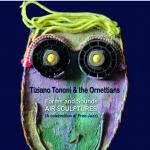Shop

PIERANUNZI Enrico
The Day after the Silence - 1976 piano solo
AFMCD165
8032050014012
Alfa Music
Italia
The Day after the Silence - 1976 piano solo
AFMCD165
8032050014012
Alfa Music
Italia
This is Enrico Pieranunzi’s second album and his first for solo piano. When it was recorded Italy was going through an explosive period of political change, which also affected the new jazz scene, which was gradually moving closer towards that of other European countries. Italian jazz was about to experience a genuine moment of renaissance, which would lead to an exponential growth in the number of musicians and the variety of trends. From the period of isolation of the great soloists such as Basso, Valdambrini, Cerri and Kramer, who followed the American style, or the avantgarde artists such as Gaslini, Intra or the Modern Art Trio, most of whom had a more European flavour and who played at an international level in which there was only room for the highest levels of excellence, Italy entered a phase that was full of new talent and new ideas. In this context Enrico Pieranunzi began to make a name for himself thanks to his originality and the technical and expressive mastery, which is so evident his music and of which this CD is an eloquent testimony.
This is Enrico Pieranunzi’s second album and his first for solo piano. When it was recorded Italy was going through an explosive period of political change, which also affected the new jazz scene, which was gradually moving closer towards that of other European countries. Italian jazz was about to experience a genuine moment of renaissance, which would lead to an exponential growth in the number of musicians and the variety of trends. From the period of isolation of the great soloists such as Basso, Valdambrini, Cerri and Kramer, who followed the American style, or the avant-garde artists such as Gaslini, Intra or the Modern Art Trio, most of whom had a more European flavour and who played at an international level in which there was only room for the highest levels of excellence, Italy entered a phase that was full of new talent and new ideas. In this context Enrico Pieranunzi began to make a name for himself thanks to his originality and the technical and expressive mastery, which is so evident his music and of which this CD is an eloquent testimony. In the seventies a large number of new musicians came to the fore. They affirmed their role in the next decade by creating a completely renovated scene, which was the foundation of today's jazz panorama. At this time also the first scuole popolari or “popular schools” of music were set up, including that of Testaccio in Rome, of which Enrico Pieranunzi was one of the founders. Nevertheless, in the general atmosphere of this crucial historical period, the Roman pianist was an anomaly, for various reasons. Above all because those years were characterised by the combination of music and politics, based on ideologies which Pieranunzi, who was then in his twenties, never really adhered to. “I had left-wing sympathies - he tells us - but I did not entirely identify with Marxist culture. I felt that music was first of all a human means of expression, rather than being something political, and that it could communicate one’s own personal politics of beauty”. Also, since Pieranunzi taught the piano at various conservatories, dealing with the preparation of concert performers, he was at that time one of the few representatives of an instrumental and academicculture that he was able to consciously use in the context of jazz, transforming it and putting it at the service of his improvisations. In addition Pieranunzi gave the impression of being a cultured young man with a refined way of speaking, who was not at all prone to shouting slogans and who had an extensive and indepth education, not just in the field of music. Finally, he had always remained true to tonal-modal structures and the forms of jazz developed from the late fifties to the sixties, thereby escaping the increasingly forceful siren song of free music, which he would practice only several years later in an original and almost never atonal manner. Pieranunzi himself understood that he was, in his words “a rather strange Italian jazz musician who created problems of categorization for some people”. Nevertheless, upon its release in 1976 the album The Day after the Silence met with enthusiastic reviews by the most authoritative critics of the time. For example
Walter Mauro wrote: “this musician is rigorous and highly controlled and he has become one of the greatest representatives of Italian jazz thanks to an exemplary record”. The review by Salvatore Biamonte praised Pieranunzi’s “masterly technique, impeccable taste and extraordinary imagination”, while the French publication Jazz Hot noted “the great sensitivity to nuances and the absence of Jarrettian tendencies” and another French journal Jazz Magazine emphasized the pianist’s “enormous technical know-how, spirit of the blues, phenomenal left hand and gifts as a composer and improviser”. Outside Europe the Canadian magazine Coda declared that he was “the most interesting pianist active in Italy, whose phrases are articulated with great care, and whose mind is as agile as his fingers”. This was a level of consensus, also from abroad, that was accorded to very few Italian musicians in those years, and Pieranunzi’s success in his homeland was consecrated by liner notes to the record written by Arrigo Polillo, the most influential critic of the time, who pointed out the diversity of the pianist’s influences, thanks to which he had been able to create an original style. I myself would add that it was also a contemporary style, because one of the most salient aspects of jazz today is its variety of references and its tendency to look back at the past without prejudice, in order to construct today's music in a new way. Pieranunzi was in fact one of the first musicians in Italy to consider jazz in this manner. The most noticeable influences on his style at the time were those of McCoy Tyner and Chick Corea, especially due to the harmonic conception of a tonal-modal type, while his compositions were already very personal and interesting, offering a wide variety of different situations reflecting a musical world full of fantasy and novel imaginative ideas. In making a brief analysis of the music on this CD we may as well start with the first piece: Prolusion. This track has a modal conception similar to that of Tyner, but it features furious bass notes that remind us of the last creations of Lennie Tristano and its progressively constructed phrasing constantly moves ahead and is supported by a dizzying technique. The title track The Day after the Silence exhibits an impressionism based on a succession of steadily breathing phrases that do not lose their rhythm but give a greater breadth and amplitude to the pulsing beat. These are features that are also partly to be found in Aurora, an almost evanescent track with delicate quartal harmonies, as well as in Blue Song, one of Pieranunzi’s first ballads, which is full of liquid sounds and is executed in an almost “classical” spirit. The third track is Trichromatic Line, which is rather obsessive with its almost minimalist micro-variations, fully in accordance with the new jazz piano ideas of the seventies. The fifth track Our Blues is a reflection on a musical genre of which he has wisely maintained the narrative structure of statement-repetition-conclusion, while the astonishing Blues Up is a pseudo boogie played at a dizzying speed with double and triple tempos that sometimes even remind one of James P. Johnson. Both of these last pieces reflect Pieranunzi’s love for the blues that, as he explains, “has practically
always been a part of me, ever since I first put my hands on the piano. It was the first musical form that my father taught me and the blues pieces of Parker, Silver and the Jazz Messengers were those on which I built my own musical language, in a total and visceral way”. This valuable re-release also offers us the two jazz waltzes The Mood Is Good, in which one detects a fleeting reference to Bill Evans, and the incisive The Flight of Belfagor. The last track on the CD is A Gay Day, a fine piece with attractive melodic European folk qualities. These then are some of the pearls of this fascinating musical creation, which was long overdue for being re-released and re-evaluated. Thus we can now rediscover a part of Pieranunzi’s personality that over the years has become an underground legacy, which still lives on in this talented jazzman’s rich and imaginative musical world.
Tracks
1 Prolusion 4.25
2 The day after the silence 3.41
3 Trichromatic line 4.36
4 Blue song 4.30
5 Our blues 2.51
6 Blues up 5.56
7 The mood is good 4.21
8 Aurora 3.28
9 The flight of Belphegor 3.59
10 A gay day 3.25
HQ Image
Our Playlist
Our olaylist on Spotify, dedicated to P
re Minimalism, Minimalism and Post Minimalism.



























